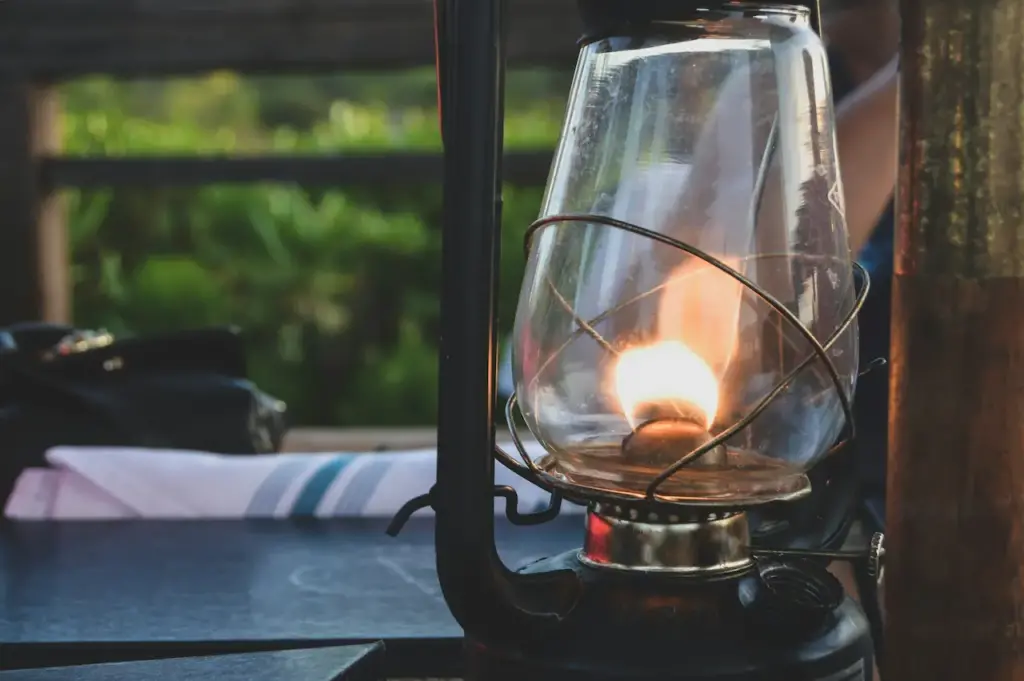Ever wondered what fuel can you use in a lantern or stove? Ever been caught out with no kerosene? There are many different types of fuel on the market, which has led to much confusion. If you are heading out camping and want to learn about lanterns? Here is what we found.
Oil lamps come in a wide range of sizes, shapes and styles. However, they all have certain safety concerns. Oil lamps need a specific fuel type to be able to light up efficiently and safely. Oil lamps typically burn half an ounce per hour. Oil lamps should be kept half full to ensure optimal burning. Some oils will burn faster than others. This guide will examine the types of fuels used to fuel oil lamps and the fuels used by old lamps over the years.
History of Oil Lamps and Fuel
The majority of homes used lamps that ran on whale oil, whale fat or camphene. By the Civil War oil refineries and oil wells were plentiful in places like Pennsylvania and Northwest Ontario. The clean-burning kerosene became a popular solution for many things, including lighthouses and locomotives. It was also used in ships, streets, and more. Kerosene was eventually replaced by electric lighting. The lamps are still used in emergencies, and instead of electric lights or candles. It is important to know what oil to use to fuel your lamp.

Modern Oils and Organic Lamp Fuel
It may seem logical to use lamp oil as fuel for your oil lamps, but you can also choose from a variety of other fuels that will produce different results. Some alternative fuels may not be suitable for vintage kerosene or paraffin lamps.
Canola Oil An derived oil from crushed rapeseed. Castor oil is a good organic lamp fuel. However, it can form resin due to the presence of unsaturated components. This can cause the wick to become clogged.
Castor oil: An oil derived from Ricinus communis, a castor bean. Castor oil is biodegradable and can be used as a renewable source of energy. Castor oil is used in Egypt, India and other countries as a fuel.
Fish oil: Oil derived from oily fish tissues. For centuries, fish oil has been used as a fuel for lamps. However, it is not very bright and can smoke after prolonged use.
Kerosene Kerosene is a readily available, affordable and refined form of oil. It was discovered by Abraham Gesner, a medical doctor and geologist. Gesner produced a clear liquid in 1846 by distilling coal. When he used this fluid to light a traditional oil-lamp, he discovered that it produced a bright yellow glow. The yellow flame was brighter than the flames produced by previous oils. He named his new liquid “kerosene” after the Greek term for “wax-oil,” “keroselaion.”
Lamp oil: A flammable, hydrocarbon oil which is usually refined and purified in order to burn without odor or soot. The labeling of clear lamp oil indicates its purity. It is designed for indoor lamps. Coloured lamp oil is suitable but could discolor or stain your lamp. While in use, scented lamp oils can become smokey. Lamp oil slowly evaporates over time. It is therefore important to store it with a cap that fits properly to get the maximum shelf life.
Olive oil: A smokeless, odorless and renewable fuel. It is an alternative to lamp oil or kerosene. Lampante oil is a low-quality virgin olive oil that is unfit for human consumption unless it has been refined. You can retrofit your olive oil lamp yourself if you don’t like using wick-type lights. Olive oil is suitable for thick wicks as it doesn’t burn until 550deg F.
Palm Kernel Oil Low-viscosity, paraffinic oil derived from the kernels of Elaeis Guineansis oil palms. Palm kernel oil is becoming rarer due to a growing demand for renewable materials. Palm kernel oil has no odor, is non-toxic and non-flammable. It’s safe to use in homes with pets or small children.
How to safely fuel your oil lamp
Mineral oil, pure gasoline, rubbing alcohol or any other fuel should not be used to power an oil lamp. The vapors, aromatics and other substances that are released by these materials when they burn can be harmful to your health. Improper fuel use can cause respiratory illness, fire or explosion. Never use household cleaners or highly flammable substances such as acetone, propane or turpentine to fill the oil reservoir.
The One Fuel is fuel for all vessels – tiki torch, oil lamp, lanterns etc. Indoor and Outdoor use. Use only in vessels that do not require a flammable fuel based on ethanol.
Torch Fuel can be used in tiki lanterns and torches that use wicks. The oil-based fuel produces a bright flame, and it will emit less smoke than the big-box tiki if you place the wick slightly above the holder. We offer two optional additives: Eucalyptus and Citronella essential oils. It has been proven that these natural products increase insect protection when combined with the base tiki fuel.
Paraffin Lamp Oil can be used indoors or outdoors in liquid candles, lanterns and torches. Virtually every restaurant in North America, Canada and Europe uses paraffin-based fuels. Paraffin Lamp Oil is virtually smoke-free and emits a pleasant smell. You can choose to use a Citronella essential oil or Eucalyptus additive, which provides a pleasant scent and some flying insect protection. Who wants to eat a flies in their soups?
CLEAN Lamp Oil, an alternative to paraffin oil. The oil is smokeless, odorless and lasted significantly longer when we tested it in-house. Amazon’s reviews of this product are a testament to its quality. And, there’s more. Even cheaper than paraffin lamp oil

Dual Fuel – What does it mean?
Dual fuel means that the product is able to be powered either by unleaded petrol purchased at the service station, or shellite. Shellite is a cleaner-burning fuel that extends the life span of the generator. Colemans’ own shellite fuel also contains a rust inhibitor and has a long shelf life.
Are they safe to use?
Absolutely. Dual Fuel lanterns are safe to use, just like any other product that uses flammable liquids.
Does it smell?
No. You will only notice a smell when you fill up the fuel tank. Dual Fuel lanterns emit no smelly fumes when in use.
How much do they cost to run?
If you assume that petrol costs $1.50 a litre, then the cost of running the stove is about $1.20 an hour and the cost for running the lantern is less than 12 cents an hour.
How bright are lanterns?
Most Lanterns emit a warm, adjustable light with 861 or 1138 lumens. These lanterns are versatile and provide a natural feel for your camping.
How hot is a stove?
Most burners can produce a heat output of up to 17000 BTU.
What could go wrong?
Clean fuel is recommended to avoid problems. Impurities can cause generators to become blocked after prolonged use.
As with any stove, it is important to have spare mantles. Most outlets have all the spares that you will need, including mantles and replacement generators.

What are the advantages of using a gas appliance?
Dual Fuel appliances have many advantages, including being inexpensive to operate, easy to monitor fuel levels, and no need to carry large pressurised LPG bottles. These appliances are reliable and work well in cold weather.
It is not unusual to hear of Dual Fuel Appliances providing reliable service over a period of 15 years.
We tried all the fuels that we could find and found low quality, inconsistent use suggestions, high price and a jumble of suppliers who had no idea what they were doing. Many claimed to have achieved purity levels which are not possible in real life. Inactive ingredients were added by several companies, which only served to contaminate the oil’s purity. Inactive ingredients such as colorants can corrupt and dilute the purity of “PURE” fuel.
I decided to do research on the fuel industry in order to find out the truth and the best products to use for each application. After all the research, my list was very short. You’d be surprised at what is sold as fuel for tiki torch, candles, oil lamp and lanterns.
Many distillers made claims about purity and consistency. Only a handful of distillers actually delivered on their promises. Then we checked with each supplier to make sure they were supplying enough and maintaining a consistent quality.



